NEWS FROM THE AUCTION AND GOLD MARKET Edition 02/2023



The House of Künker and the world of numismatic scholarship have maintained friendly relations for decades. On the eve of our Berlin auctions, we asked the former director of the Berlin and Gotha coin cabinets, Dr Wolfgang Steguweit, to speak about the importance of private and public collections at the Berlin office of Kunsthaus Lempertz. Anyone who knows Wolfgang Steguweit knows the enthusiasm that he conveys in his lectures.
Calendar 2023
Preamble – our first “Künker Exklusiv” in English. For the past years we have been compiling interesting articles surrounding our auction sales, the coin trade and the numismatic world in general and have been publishing these in our “newspaper” – the “Künker Exklusiv”. We are happy to present to you here the first edition of the Künker Exklusiv in English! With our large spring auction sale just around the corner, and so many interesting articles surrounding topics like coin provenances we felt this is the right time to present these articles to an even wider audience and our English-speaking customers.
For Künker, 2023 got off to an exceptionally exciting and eventful start, and we have a lot to report. For example, we have already participated in three international coin fairs: the FUN in Orlando, the NYINC in New York and the World Money Fair in Berlin, where we have now also concluded our first 2023 auctions 379 and 380 with great success. All three fairs had one thing in common -- new attendance records were set!
To sum it all up: The coin market continues to be stable at a high level at the beginning of 2023, and the international demand for rare and well-preserved coins and medals will remain strong.

On the following pages we report in detail on the impressions our teams gathered at the fairs in Orlando, New York and Berlin. Of course, we also report on our auctions 379 and 380, which took place in Berlin. We were particularly pleased to finally welcome a large number of bidders to the floor again, after a three-year break due to the pandemic.
And numerous customers and friends of coins accepted our invitation. In front of a well-filled hall, Wolfgang Steguweit described the roles which private collectors and coin cabinets in public hands play in the preservation and publication of numismatic treasures. As part of his talk, he put special pieces from the Gotha Cabinet and from the Salton Collection into a dialogue. His conclusion: In order to preserve numismatics as a scholarship – and not only to preserve the objects, but also to research them and publish the findings – joint efforts by the public sector and private collectors are necessary.
Another focus of this issue of “Exklusiv” is the presentation of Künker events coming in the near future. Of course we are referring to our Spring Auction Sales from 16 to 24 March in Osnabrück. We will once again have the honour of presenting to you numerous numismatic highlights in the form of rare and valuable individual items, but also in the form of whole collections. Read more about these collections and the famous previous owners of some of the associated pieces here. The people who assembled these magnificent collections are of particular importance to us. Here, we introduce you to some of them. In one of our auction previews on “Auction 383 –The Roger Wolf Collection”, we address the ever-increasing importance of provenance, which is currently on the rise (not only) in the case of ancient coins.
We hope you enjoy reading our latest issue, and we are very much looking forward to seeing you in person again soon! With Best Regards from Osnabrück,
Dr. Andreas Kaiser Ulrich KünkerImprint
Publisher Fritz Rudolf Künker
GmbH & Co. KG


Nobbenburger Straße 4a
49076 Osnabrück
Germany www.kuenker.de
Editor Julia Kröner
Inja MacClure
With issue by Prof. Dr. Johannes Nollé
Typesetting and layout
Helge Lewandowsky
Translation Wordboss, Osnabrück www.wordboss.de
Teresa Teklic
Responsilble according to press law
Ulrich Künker

Those who study catalog 383 with the coins of the Roger Wolf Collection will notice that it is designed differently than our usual catalogs. Regarding many ancient coins, not only the piece itself is depicted but also the image of its first appearance on the market. In this way, we want to enable those who do not own an extensive library of auction catalogs to exactly understand where a piece came from. There is a good reason for this. Being able to prove the provenance of a coin has gained in importance – especially with regard to ancient coins.
Many countries of origin of ancient coins implemented export licensing procedures that apply to cultural goods, including coins, that left the respective country after a specific date. The German Cultural Property Protection Act stipulates that the legal export of a coin must be proven either by an export license – which in most cases does not exist –or by demonstrating that the coin in question was already outside the country of origin on the set date. The easiest way to prove this is by providing evidence of its provenance, i.e. by demonstrating that the coin was already on sale before this date. Such documentation will clearly identify the coin and specify the date and the venue of the sale.
Of course, this does not mean that all the coins whose provenances are not indicated in the catalog may not be traded. We always carefully check that the pieces you purchase from us are permitted to be traded in compliance with the German law. Time and again we happen to find a coin or a medal in a collection that was stolen from a public collection –often already during the Second World War. In such a case, it is very important for us to facilitate an amicable solution between the institution and the coin’s current owner. In this way, for example, we were able to re-unite the Klassik Stiftung Weimar foundation with a gold version of the “Alchemistentaler” by Frederick I of Saxe-Gotha-Altenburg in 2019. An unknown person had stolen it from Weimar along with a total of 200 numismatic objects during World War II. The piece was first sold at auction in New York as early as in 1950. Since then, it had been part of a private collection that was consigned to us in 2017. Although the then holder of the coin did in fact become its legal owner through “usucaption”, as a lawyer would say, we decided to cover the costs of restitution ourselves due to the great historical significance of the coins.
Prices for coins with provenances that reach far back have increased in recent years. The London-based collector Roger Wolf became aware of this development and decided at some point in his collecting live to refrain from purchasing any specimen whose provenance could not be traced far back.
Even if it is not necessary to exactly follow such a strict approach, we recommend that you keep careful records of where and when you bought a coin. This is important for both the maintenance of value and legal aspects. If you want to sell your collection at some point, these records will be worth real money.
We are pleased to present a particularly extensive offer of coins with provenances that reach far back in both Spring Auction Sales. And we would like to draw your attention to another wonderful side effect: thinking of all the people who held a coin in their hands before you did is a great feeling, is it not? And it is even more exciting if you know the names – and the biographies – of some of these owners. In this article, we would like to introduce you to some of the best-known collectors whose coins are on offer in our auctions 382 and 383.

When this provenance is given for a coin, one must carefully consider which one of the two Evans is meant. After all, the Evans family can almost be referred to as a dynasty of archaeologists and numismatists.
Let us begin with Sir John Evans. He married rich, namely his cousin who inherited a paper mill. This generated a generous income, which enabled him to live his passions – archaeology and numismatics. He mainly collected Roman coins, served as President of the Royal Numismatic Society from 1874 to 1908 and was involved in the excavation of remains of Palaeolithic settlements at Kents Cavern.

His eldest son Arthur inherited not only his father’s fortune but also both passions of his. He became famous for his excavations at Knossos, which were not only headed but also financed by him. At the same time, he built up an extensive collection of coins from Magna Graecia, which he auctioned off at Sotheby’s in 1898 under a pseudonym. He had already sold the largest part of his father’s collection shortly after his death.
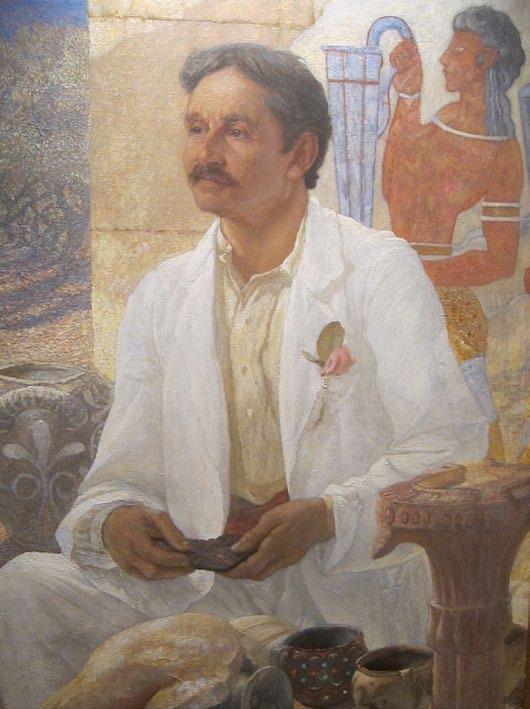
But this did not mean that Sir Arthur Evans stopped his collecting activities. When he died, he possessed about 10,000 coins, which he bequeathed to the Ashmolean Museum. We can offer two coins from the collection of the son: No. 33 and No. 2011.
Sir Hermann Weber (1823-1918)
Coin collecting is a popular hobby among doctors – and it always has been. One of them was Sir Hermann David Weber. He was born as the son of an estate manager in the Bavarian town of Holzkirchen and moved to England after completing his medical degree in 1851. There, he was first employed by the German Hospital in London. The institution cared for the about 30,000 German refugees who had been given shelter in London’s East End after the Revolutions of 1848. Most of them lived in miserable conditions and were in need of free medical care. The German Hospital was considered an exemplary clinic. We know this, among other things, because Florence Nightingale decided to complete her training as a nurse in the German town of Kaiserswerth after visiting this very hospital.
Hermann Weber must have been an impressive young doctor with innovative ideas. Given the incredible number of patients suffering from tuberculosis, he developed a course of treatment based on the healing effects of fresh mountain air. This made Weber a pioneer of open-air treatment and Queen Victoria knighted him for this achievement.
In his free time, the ageing Weber occupied himself with numismatics. He assembled an extensive collection of Greek and Roman coins, of which we can offer you as many as two Greek coins in our auction 382, namely No. 88 and 138.
Clarence S. Bement (1843-1923)Her father’s inheritance enabled Clarence S. Bement to build up a sizeable collection of American, Roman and Byzantine coins. The entrepreneur from Philadelphia ran a tool factory by day
and relaxed by collecting in the evening. At first, he assembled a large-scale collection of minerals. When he sold it, two freight cars were required to transport the 12,500 items to New York, where they found a home at the Museum of Natural History.
All in all, Bement only collected ancient coins for 15 years. Despite this short amount of time, he succeeded in creating an extraordinary collection. When it was sold by Naville, the items were documented on 132 collotype prints. This is remarkable because only about a handful of outstanding pieces used to be honored with a depiction before a sale in the 1920s.
We offer you a particularly rare late Roman coin from the Bement Collection.
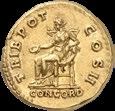
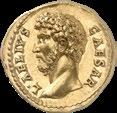
Samuel Jean Pozzi (1846-1918)
His coin collection was probably the least glamorous aspect in the life of this eminent French gynecologist, surgeon and politician, whose medical achievements saved the lives of thousands of women and soldiers. This caused him to be admitted to the French Legion of Honor as early as in 1886, and to be appointed Grand Officer of the French Legion of Honor in 1914.
Pozzi was a typical offspring of the Parisian Belle Epoque. His wife came from a wealthy family. She provided him with the necessary means to shine in the city’s salons and to maintain numerous expensive mistresses, including – perhaps – the great actress Sarah Bernhardt. In 1909, his wife and youngest son left the household. Pozzi was probably not bothered by this. Family was not important to him. He socialized with the most famous artists of his time, including Alexandre Dumas the younger, Marcel Proust and Guy den Maupassant.
From 1898 to 1903, Pozzi represented the Dordogne region in the French Senate, where he was particularly committed to the cause of an educational reform. We also know that he sided with Zola in the Dreyfus affair, opposing the anti-Semitism that prevailed in the army.
Auction 382, Lot number 33
Acragas (Sicily). Tetradrachm, 410-406. Sir Arthur Evans Collection, sold by Sotheby, Wilkinson & Hodge (1898), No. 43; John Ward Collection; Metropolitan Museum of Art Collection, sold by Sotheby (1973), No. 114 and Sotheby (1990), No. 20. Very rare. Very fine.
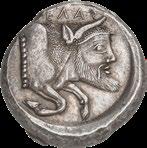
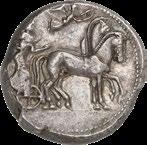



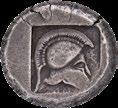


Estimate: 15,000 euros.
Auction 382, Lot number 2011
Gela (Sicily). Tetradrachm, 480/470 BC. Specimen from the R. Jameson Collection, Paris 1913, No. 575 (purchased from the Arthur J. Evans Collection) and the Mark and Lottie Salton Collection, auctioned off by Stack's Bowers Galleries in conjunction with Künker, New York, 16 January 2022, No. 4112. Splendid patina, extremely fine.
Estimate: 15,000 euros.
Auction 382, Lot number 88
Letaioi. Stater, 525-500. Hyman Montagu Collection, sold by Sotheby, Wilkinson & Hodge (1896), No. 192; Sir Hermann Weber Collection, No. 1821; R. Jameson Collection, No. 1951; Salton Collection, sold by Stack’s Bowers (2022), No. 4174. Very rare. About extremely fine.
Estimate: 25,000 euros.
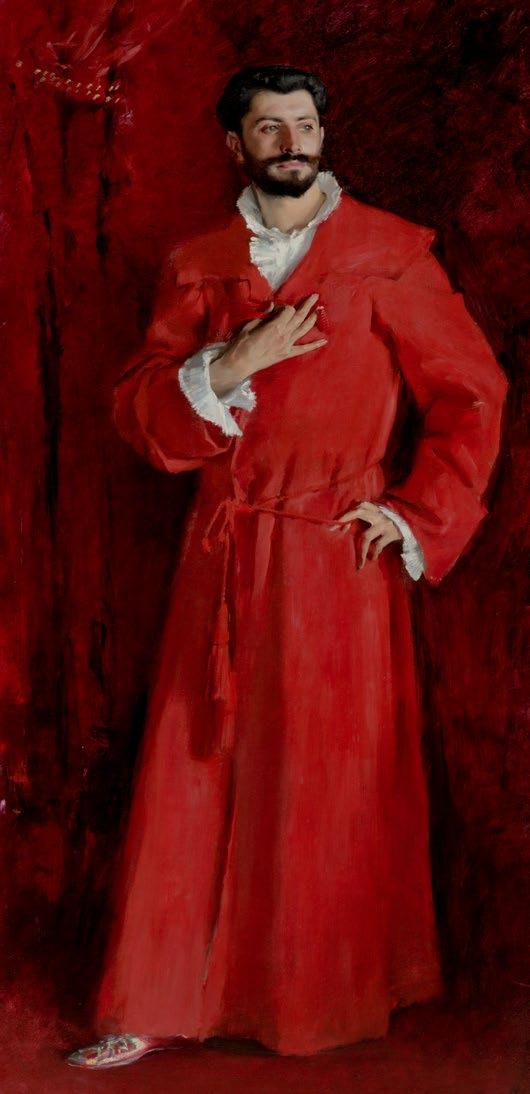
Auction 383, Lot number 2157
Joannes (423-425). Solidus, Ravenna. Hirsch auction XV (1906), No. 1437; Bement Collection, Ars Classica auction 8 (1924), No. 1583; Victor Adda Collection, Leu Numismatik auction 77 (2000), No. 748; NAC auction 120 (2020), No. 893. Very rare. Extremely fine.
Estimate: 12,500 euros.
Auction 383, Lot number 2033
Sicyon (Peloponnese). Stater, 431-400. Pozzi Collection, Ars Classica auction I (1920), No. 1799; Lockett Collection, Glendining auction (1959), 1904; Künker auction 288 (2017), No. 158. Rare. Very fine to extremely fine.



Estimate: 2,000 euros.
Auction 383, Lot number 2128
Severus II, 305-307. Aureus, 305/6, Ticinum. Very rare. Friedrich von Schennis Collection, Hirsch auction 33 (1913), No. 1463; Virgil M. Brand Collection, Sotheby auction (1983), No. 452; NAC auction 54 (2010), No. 607; Künker auction 174 (2010), No. 1004; NAC auction 102 (2017), No 573. Extremely fine.

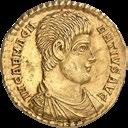
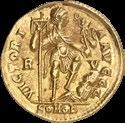


Estimate: 15,000 euros.
Auction 383, Lot number 2095
Macrinus, 217-218. Aureus, 218. Jameson Collection (1913), No. 205; Biaggi Collection, No. 1268; NAC auction 40 (2007), No. 778; NAC auction 84 (2015), No. 1084. Very rare. Extremely fine to FDC.
Estimate: 60,000 euros.
Auction 383, Lot number 2087
Pertinax, 193. Aureus. Archer Milton Huntington Collection, No. ANS 1001.1.300332, NAC auction 67 (2012), No. 7546. Very rare. Extremely fine.
Estimate: 30,000 euros.
Auction 383, Lot number 2142
Magnentius, 350-353. Solidus, Trier. Niggeler Collection III, Leu / MMAG auction (1967), No. 1636; Bank Leu auction 48 (1989), No. 432; NAC 54 (2010), No. 630. Rare. Extremely fine.
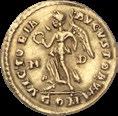



Estimate: 5,000 euros.
Auction 382, Lot number 561
Eugenius, 392-394. Tremissis, 393/4, Mediolanum.

Leo Biaggi de Blasys Collection, No. 2315; Giuseppe Mazzini Collection, No. 10v; NGSA auction 8 (2014), No. 181. Rare. Very fine.
Estimate: 15,000 euros.
Auction 383, Lot number 2037
Abydos (Troas). Tetradrachm, around 80/70 BC.

Merzbacher auction 22 (1910), No. 656; von Aulock Collection No. 1454; Leu auction 13 (1975), No. 208; Künker auction 288 (2017), No. 174. Rare. Extremely fine / About extremely fine.
Estimate: 1,500 euros.
Auction 383, Lot number 2077
Aelius, Caesar under Hadrian. Aureus, 137. Biaggi Collection, No. 689; NAC auction 51 (2009), No. 284; NGSA auction 6 (2010), No. 168. Rare. Extremely fine.
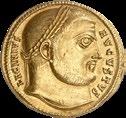


Estimate: 20,000 euros.
Auction 382, Lot number 72
Lipara. Hexas, 440-420.
Clain-Stefanelli Collection, Naville auction 23 (2016), No. 136; NAC 120 (2020), No. 316. Rare. Traces of overstrike, otherwise very fine.
Estimate: 1,000 euros.
Auction 383, Lot number 2131
Licinius I, 308-324. Aureus, 316, Nicomedia.

Nelson Bunker Hunt Collection, Sotheby auction (1991), No. 931; The New York Sale XXIII (2010), No. 240. Very rare. Extremely fine.
Estimate: 7,500 euros.
Besides coins, Pozzi collected a series of paintings, sculptures and tapestries. He also collected glass objects by Lalique, Tanagra figurines and much more. They formed the extravagant background of his Paris apartment, where he received guests from all over the world.
Pozzi’s death was just as extraordinary as his life. He was shot dead by a former patient on 13 June 1918 because the man was convinced Pozzi had made a mistake when treating him, resulting in his impotence. Pozzi did not die in that moment. Under partial anesthesia, he instructed the surgeons operating on him but eventually died during the procedure.
Collectors who own a coin from the Pozzi collection have thus a direct connection to the life of the jeunesse dorée of the Parisian Belle Epoque.
Friedrich von Schennis (1852-1918)
The painter Friedrich von Schennis was from a Swiss merchant family that had settled down in Elberfeld, which was referred to as “German Manchester”. His artistic talents already became apparent when he was just a child and he showed little interest in taking over his father’s company. His family enabled him to study at the Academy of Art in Düsseldorf, where the Düsseldorf School of Painting developed under the leadership of Wilhelm von Schadow and Peter Cornelius. Friedrich von Schennis is considered part of this movement, alongside artists that are as contrasting as Arnold Böcklin, Wilhelm Busch and August Macke.
Friedrich von Schennis is not one of the best-known artists of the Düsseldorf School of Painting. His father’s fortune allowed him to paint for pleasure. His contemporaries regarded him rather as a bohémien, gentleman or dandy. They readily visited his generous household in the Berlin district of Charlottenburg and viewed his extensive collection, which included not only paintings, books and tapestries but also coins. We can offer you an impressive example in our auction 383.
Fréderic Robert Jameson (1861-1942)
You will encounter five coins from the Jameson Collection in our auction sale. Lots No. 88, 138, 2011, 2095 and 2111. They were all scholarly published because Jameson himself made sure of this for all his 2,620 Greek and 538 Roman coins.
Robert Jameson was used to meticulous work. His mother’s family owned a bank, whose head office had been moved from Switzerland to Paris. Robert Jameson was a banker himself and saw to his interest in numismatics in his free time. He purchased many coins in person at Paris auction sales; abroad, the coin shops of Rollin & Feuardent and Naville acted on his behalf. Jameson’s extraordinary standards of quality were already well-known during his life time. Therefore, the reference “Ex Jameson Collection” is a special distinction for a coin.
Archer Milton Huntington (1870-1955)
Archer M. Huntington never had to work. The (adopted) stepson of railroad magnate Collis P. Huntington, he inherited a quarter of the Southern Pacific Company, one of the two major railroad networks in the US, when his father died in 1900.

Huntington was obsessed with Hispanic culture und collected everything related to this subject. In 1904, he founded the Hispanic Society of America and built a museum for it in New York, into which the American Numismatic Society was to move later. Huntington was a philanthropist, who bequeathed his collections to the public and spent a large part of his money on charitable causes as he himself did not have children.
His coin collection, which was co-curated by the ANS for decades, was sold in 2011 to help the Hispanic Society of America navigate financially difficult times. We are pleased to be in a position to offer two lots from the Huntington Collection: No. 2087 and No. 2089.
Walter
Those who purchase coins from the Niggeler Collection know what this name stands for: Unlike his contemporaries, Niggeler paid particular attention to the quality of his coins, which is why “Ex Niggeler Collection” already indicates that the piece in question is of outstanding quality. He was able to afford it. He came from a wealthy family. He did not take over his father’s textile company but headed the department for energy transformation and distribution at Brown, Boveri & Co. His income went into his collections and his apartment that bursted with art treasures and coin boxes was legendary.
We are pleased to offer several coins from the Niggeler Collection: No. 138, 364, 530 and 2142.
Giuseppe Mazzini (1883-1961)
Giuseppe Mazzini was an industrial magnate from northern Italy. He was Director of the Turin Savings Bank and of the financial institution called Istituto Mobiliare Italiano. Moreover, he headed the “La Stampa” newspaper as Chairman of the Board and was a consultant for the FIAT car manufacturer. A passionate fencer, he first headed the Italian Fencing Federation and went on to become President of the International Fencing Federation in 1953. In addition, Mazzini was politically active. Mazzini was first a Liberal Democrat, then a Fascist – and yet, this only put an end to his political career after the war.
Numismatists are familiar with Mazzini due the five volumes published by Mario Rotti that present Mazzini’s collection. Mario Ratto purchased a major share of the collection to sell it to his customers. In auction 382, we offer an extremely rare tremissis of Eugenius from the Mazzini Collection.
Hans von Aulock (1906-1980)
Collectors of coins from the cities of Asia Minor will certainly be familiar with the name von Aulock. For many years, his collection was the best (and often the only) reference that allowed collectors to identify these coins.
The family of Hans von Aulock was part of the old Silesian nobility. An export merchant and banker, he already moved to South Africa at the age of 24. In 1941 he became head of the Istanbul branch of the Deutsche Orientbank (German Bank of the Orient).
Von Aulock was critical of National Socialism. Therefore, he sought asylum in Turkey when Germany and Turkey broke off diplomatic relations. In 1952, the Dresdner Bank appointed him Director of their Istanbul branch. This did not only enable him to buy coins at auction but also gave him the opportunity to regularly go to the bazaar and look for ancient coins that were waiting to be melted down. Many numismatically valuable coins were preserved for research because Hans von Aulock literally saved them from the melting pot.
In 1980, he and his wife passed away in a car accident. Since Hans von Aulock was one of the first to deal with the coins from Asia Minor of the Roman imperial period, his collection inspired generations of researchers.
We are pleased to offer you one coin of the von Aulock Collection in auction 383.
Leo Biaggi de Blasys (1906-1979)Originally from Switzerland, the family of Leo Biaggi de Blasys made a fortune in the sugar producing industry. After the First World War, their factory became part of the Italian sugar syndicate. This enabled Biaggi to devote himself to his own interests. Starting in the 1930s he lived mostly in Genoa, later in Spain. He was a Delegate of the International Red Cross in Italy from 1943 to 1976. Together with his father Giovanni, a then Swiss consul in Genoa, he helped many people escape. Thanks to the Biaggi family, numerous Jews were able to flee. But some Nazis, too, fled justice with the help of papers that Biaggi had signed. Biaggi assembled an extensive collection of high-quality gold coins, of which we offer the following pieces in auctions 382 and 383: No. 465, 549, 561, 2062, 2077, 2085, 2130 and 2156.
Female coin collectors are few and far between – which is why we are all the more excited to offer you coins from the collection of Elvira Clain-Stefanelli. Her life was rather adventurous as well.
The daughter of a Bucharest high school teacher, she was one of a few women that had the chance to go to university prior to World War II. There she met her future husband, Vladimir Clain, who was already an aspiring numismatist at the time. Against their parents’ wishes, the two became engaged and married when Vladimir got the chance to work at the Romanian archaeological academy in Rome. Disaster struck when his passport was stolen there one day: with the help of the passport a persecuted man managed to escape from Nazi Germany – and Vladimir was sent to the Buchenwald concentration camp. Elvira voluntarily followed him with their newborn son Alexander.
We do not know how the family escaped from Buchenwald. But Elvira Clain-Stefanellis recounted in a detailed interview that the family had already made their way to Italy before the war ended. The couple was able to make a living by working for
the Santamaria coin shop in Rome. But since Vladimir’s place of birth was now part of the Soviet Union, the family run the risk of being deported to Russia. A friendly official made it possible for them to emigrate to the United States. There the couple first worked for Stack’s, then for the Smithsonian Institution, whose coin collection significantly expanded under their leadership. In the years between 1956 and 1982, from 60,000 to 960,000 pieces
We are pleased to offer a specimen from the private collection of Elvira Clain-Stefanelli.
Nelson Bunker Hunt is not only famous but downright infamous. He was one of the seven children of oil billionaire H.L. Hunt, whose family life is considered the model of the soap opera Dallas. Nelson was a shrewd businessman, founder and owner of the Titan Resources Corporation, which specialized in oil exploration. His company played a crucial role in the exploitation of Libya’s oil fields.
One may well wonder whether Gaddafi’s nationalization of these oil fields in 1973 is in any way connected to Nelson Bunker Hunt’s decision to manipulate the silver price. Together with his brothers William and Lamar, he acquired vast quantities of silver to propel the prices upwards. The Hunt’s scheme is still described as a worst-case scenario in every economics textbook. On Silver Thursday – 27 March 1980 – the silver price crashed. It left the Hunt brothers with $1.7 billion in debt that they could not pay. To stabilize the financial system, the creditors supported the brothers, allowing for their bankruptcy to unfold in a slow and organized manner. In this process, the comprehensive coin collection of Nelson Hunt was sold, which he had purchased through Bruce McNall. The Hunt affair ended in 1989 in a financial compromise that left Nelson Hunt with enough funds to run a horse farm in retirement – just for fun.

Our article on provenance inspired us to present the preview for our medieval and modern coins from the Spring Auction Sales in a somewhat unusual way as well. After all, who would we be without the collectors who trust us with their collections? In the three catalogues for Auctions 364 through 386, you’ll find a total of eleven special collections!

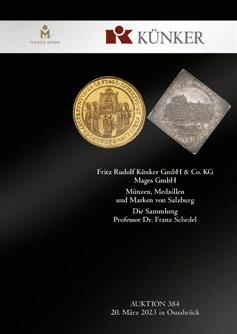

Prof. Dr. Franz Schedel (1915-1996):
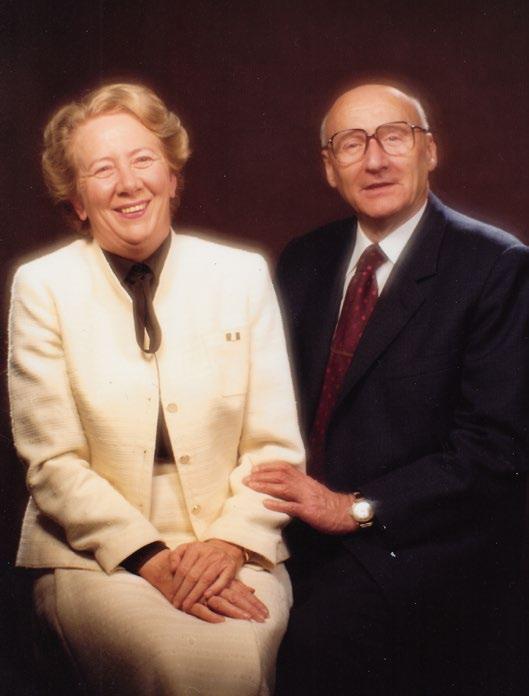
Coins from Salzburg
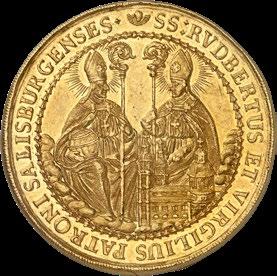
Prof. Dr. Franz Schedel must have been a remarkable personality. Many people owe him their life and health, and many people in Passau their living. Franz Schedel was not only a brilliant surgeon but also a great chief of surgery and hospital managing director.
In 1941 Schedel got his medical license and began practicing under the most brutal circumstances: He was deployed to the front, where he saved the life of many a wounded soldier. After the German defeat Schedel first worked in Munich before accepting an offer from the hospital in Passau, which was still fairly small at the time. As chief of surgery and medical
Auction 384, Lot number 2803 Salzburg. Paris von Lodron, 1619-1653. Quadruple Reichstaler 1628. Very rare. Very fine.



Estimate: 20.000 euros
director of the hospital, he turned the institution into the leading hospital in the region. Today the hospital is the largest employer in and around the city of Passau.
Next to managing the hospital, Schedel recognized the necessity of follow-up treatment at the highest level early on. That is why he founded his private health clinic “Kurklinik Dr. Schedel,” today one of Bavaria’s biggest oncological rehab hospitals. He also initiated the opening of the sister clinic in Brandenburg’s Spreewald region (near Berlin) in 1996 before passing away on August 20, 1996.
Prof. Franz Schedel dedicated his spare time to numismatics. He assembled a collection of coins and medals from Salzburg, whose many multiple ducats and multiple thalers are surely the

Auction 384, Lot number 2950 Salzburg. Johann Ernst von Thun und Hohenstein, 1687-1709. 25 ducats 1687. Purchased from Partin Bank, Bad Mergentheim. Extremely rare. Extremely fine +. NGC MS 61.
Estimate: 75,000 euros
most impressive ensemble that has come onto the market in recent decades.
Frank Bader
Collector Frank Bader wants his collecting work to be remembered rather than his life. He assembled an extensive collection of coins, medals, orders and decorations which document Absolutism, Enlightenment, and the French Revolution.
The concept behind this collection is highly complex. The idea was to show how the changes from absolutist rule to Enlightenment and the Age of Revolution were reflected on coins and numismatics in general.
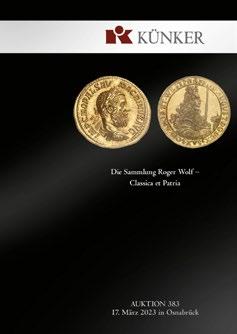
Auction 385, Lot number 3854
Russia. Elizabeth, 1741-1761.
10 roubles 1756, Moscow, Red Mint.
Very rare. About extremely fine.
Estimate: 10,000 euros
Auction 385, Lot number 4097
France. Medal commemorating the guillotine of Lyon (1793).
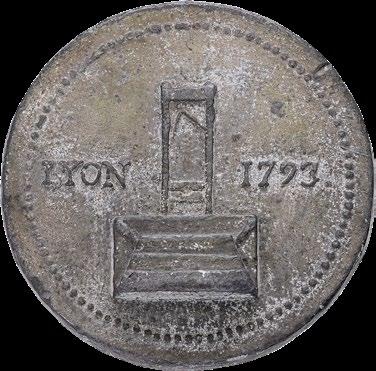
Probably lead cast. II.
Estimate: 75 euros
That is why, geographically, the collection stretches all across Europe; temporally, from the French Revolution all the way back to the predecessors of the first enlightened monarchs, the focal point being “philosopher princes” like Frederick II. of Prussia and Katharina II. of Russia.
The collection is rounded off by touching recollections from the French Revolution. Who would not be touched, after all, by a contemporary medal that had been dedicated by its contemporaries to the guillotine? It refers to the end of the Jacobins’ reign of terror in Lyon. In March 1793, they installed a guillotine to enforce their drastic measures. On May 29 the citizens had had enough of this reign of terror. They overthrew the sans-culotes and sent them to the scaffold themselves on July 16.
This is remembered on the medal, whose inscription reads, roughly translated: “Those who sent so many [to their deaths] have now been sent themselves.”
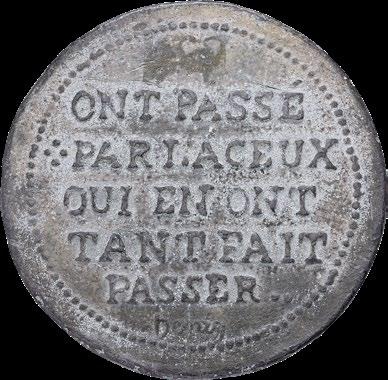
Peter Fleige *1935
How important coin collecting relatives are shows the collector’s career of Peter Fleige, whose father brought him along to numismatic evenings with Professor Wilhelm Jesse in Braunschweig already at an early age. The uncle was a collector too. He lived in Osnabrück and introduced his nephew to the “Münzbolde” society when he was still in school. The “Münzbolde” (roughly: Coinlings) met at the house of notary Buller, which would go on to become the long-standing head office of the Künker coin dealership.
Peter Fleige majored in law but decided not to enter the public service. Instead, he was recruited by Siemens and worked in the company’s finance department until his retirement.
Peter Fleige is still an enthusiastic coin collector even though he has decided to part with some of his collection. Connoisseurs can look forward to exquisite bracteates.
Prof. Dr. Alois Matthias Memmesheimer (1894-1973)

Professor Memmesheimer, too, belongs to the large group of physicians who find rest in their free time by collecting coins. His family hails from the Palatinate; Memmesheimer himself was born in Saarbrücken, grew up in Bad Kreuznach and did his military service in Berlin, in the renowned regiment 1st Guards Grenadiers. He stayed in Berlin to read medicine and gained handson experience as a paramedic and physician assistant in World War I – even before completing his studies.
Memmesheimer specialized in dermatology. He was already an internationally renowned expert in his field when he was offered the position of head physician at the dermatology clinic in Essen. Yet he became a target for criticizing the Nazis. In 1933/4 he faced imprisonment and was not allowed to publish his scientific works any longer or visit congresses abroad. Fortunately several of vice chancellor Franz von Papen’s staff members worked to return the respected physician to his old position. Good dermatologists were in demand, especially in the military, where he served even before the outbreak of World War II.
After World War II Memmesheimer returned to Essen. He found his dermatology clinic in ruins. Out of the 1,400 beds which the clinic had had before the outbreak of the war a mere 45 beds were left over after the horrific air raids between 1942 and 1944, all of them in the air-raid shelter. Alois Memmesheimer literally rebuilt “his” dermatological clinic. On top of that he remained an active researcher and lecturer. As early as 1949 the members of the German Dermatological Society appointed him their treasurer. Between 1960 and 1965 he served as president of the society. On his death in 1973 he was among the most renowned dermatologists worldwide and remembered in many obituaries by international journals.
Auction 386, Lot number 4547
Arnstein. Walter II, 1135-1176. Bracteate, Hettstett. Auction WAG 8 (1997), no. 32. Very rare. Extremely fine.

Estimate: 3,000 euros
Auction 386, Lot number 4576
Bracteates. Aschaffenburg as mint of the Bishop of Mainz. Conrad of Wittelsbach, 1183-1200. Bracteate. Peter Fleige Collection. From the 1st Odenwald Hoard (Berliner Münzblätter 1885, p. 577). Very rare in this quality. Extremely fine to FDC.



Estimate: 5,000 euros
For recreation, Alois Memmesheimer found joy in numismatics. His comprehensive collection of coins and medals from the Palatinate was already sold at auction in 1979. Now his collection of coins from Mainz follows suit.
In addition to the Memmesheimer collection, we are able to offer you the impressive Mainz collection of Heinz Beaury.
The noble house of Freiherr von Schuckmann hails from Westphalia but, already in the first third of the 17th century, the ancestors of Siegfried von Schuckmann settled in Mecklenburg, where his father farmed Raakow manor, measuring some 500 hectares.
Auction 386, Lot number 4708
Mainz / Bishopric. Georg Friedrich von Greiffenklau zu Vollrath, 1626-1629. Gold florin 1627, Frankfurt. Very rare. Extremely fine.
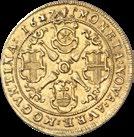

Estimate: 15,000 euros
Auction 386, Lot number 4780
Mainz / Bishopric. Lothar Franz von Schönborn, 1695-1729. Silver medallion 1707 commemorating the bishop's 52nd birthday, by Andreas Kötzner. Very rare. Extremely fine-uncirculated.



Estimate: 5,000 euros
1,5:1
Auction 386, Lot number 4856
Mainz. Karl the Great, 168-814.
Denarius 771-793, Mainz. Collection Heinz Beaury.

Very rare. Extremely fine.
Estimate: 10,000 euros
Auction 386, Lot number 4872 Mainz / Archbishopric. Lothar Friedrich von Metternich-Burscheid, 1673-1675. thick double Reichstaler 1674. From Schink Collection, auction Frankfurter Münzhandlung (1993), no. 911; Heinz Beaury Collection. Very rare. Extremely fine.
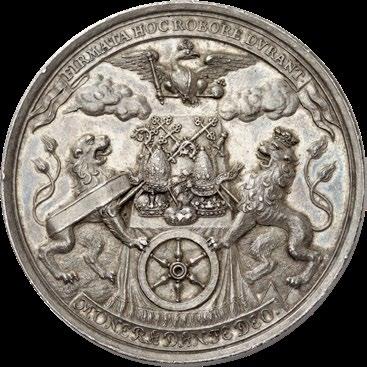

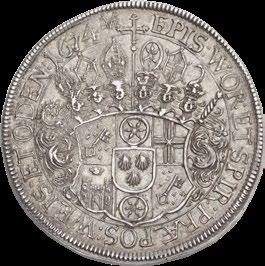
Estimate: 30,000 euros
Peter Fleige

This is where Siegfried von Schuckmann grew up, until the whole family had to flee to Western Germany in January 1945. As a young man Siegfried saw no future in post-war Germany. He emigrated to Colombia, where he trained as a salesman in Cali. He put his skills to use in companies in New York and Caracas before founding his own company Industrial ESCO there in 1965. ESCO was a success story. And Siegfried von Schuckmann was left with little time to pursue his hobby, numismatics.
Since 1977 coin collecting had been one of his favorite pastimes. He sold his first collection as early as 1999, but immediately began assembling a second one dedicated to the Spanish War of Succession. It was sold at auction by Künker in 2017. Then 88 years old, von Schuckmann once more began collecting. His third collection, dedicated to “Napoleon and his time,” will be sold in Auction 386 and in eLive Auction 77. We can’t wait to see what the 94-year-old coin enthusiast will begin to collect next.



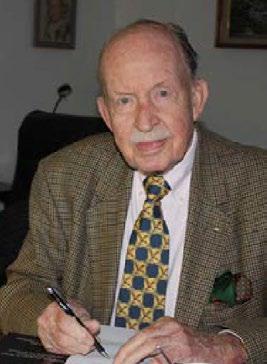
Auction 386, Lot number 5470
Siegfried Schuckmann Collection / Napoleon and His Time. Kingdom of Westphalia. Hieronymus Napoleon, 1807-1813. 1 franc 1808. Extremely rare. About FDC.
Estimate: 2,500 euros
Auction 386, Lot number 5560 France. Napoleon / Consulate, 1799-1804. Silver medal year III (1800), by L. Manfredini. Napoleon Bonaparte as President of the Cisalpine Republic. Gorgeous patina. Extremely fine.

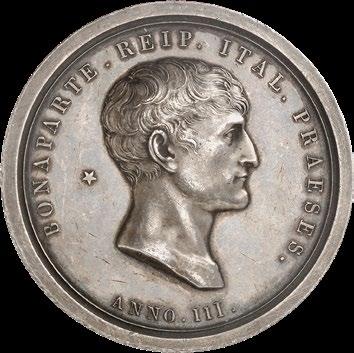


Estimate: 1.500 Euro
Auction 386, Lot number 4972 Bentheim. Moritz, 1623-1674. Triple reichstaler 1657, Rheda. Cygnus in Nummis Collection. The only known specimen. Very fine. Estimate: 40,000 euros
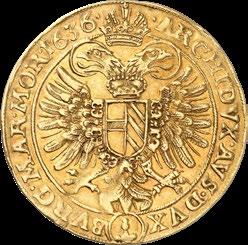
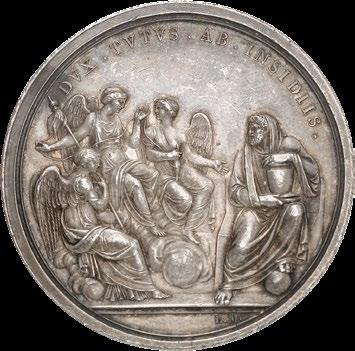
Auction 386, Lot number 5819 Great Britain. Mary, 1553-1558.
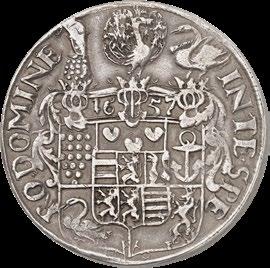
Gold medal n.d. (around 1554), by J. da Trezzo. Only 2 copies known. One copy in private property and the other one is in the collection of the British Museum. Outstanding Renaissance medal. Piece of the Coll. Baroness Batsheva von Rothschild, Christie's auction, London, December 14, 2000, no. 36 (previously probably owned by Baron Alphonse de Rothschild, 1827-1905). Original cast.


Extremely rare. Extremely fine.
Estimate: 600,000 euros
Auction 386, Lot number 5064 Brunswick-Wolfenbüttel. Ferdinand II, 1735. Reichstaler 1735, commemorating his death on 13 September.
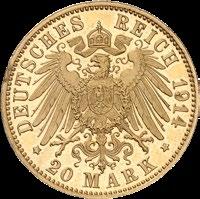
From Peus auction 270 (1969), No. 574. Extremely rare. About FDC.
Estimate: 12,500 euros
Auction 386, Lot number 5856 Russia. Elizabeth, 1741-1761. Broad gold medal by J. Dassier, commemorating the foundation of the Moscow State University in 1754, minted in 1758.
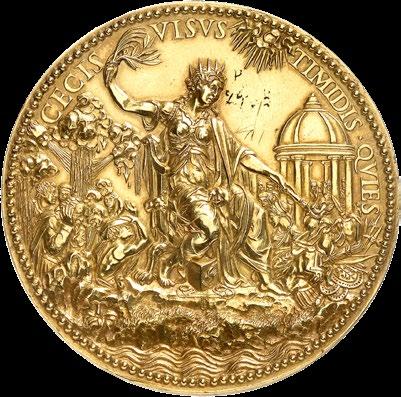
From Schlessinger auction (1934), No. 436. Extremely rare. Extremely fine.
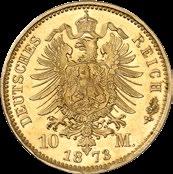
Estimate: 50,000 euros
Auction 386, Lot number 5991
Holy Roman Empire. Ferdinand II, 1592-1618-1637. 5 ducats 1636, Prague. Incised face value V on the obverse.



Very rare. Very fine +.
Estimate: 50,000 euros
1,5:1
Auction 386, Lot number 6186
German Empire. Mecklenburg-Strelitz.
Frederick William, 1860-1904.
10 marks 1873. Very rare. FDC.
Estimate: 60,000 euros
1,5:1
Auction 386, Lot number 6355
Bavaria. Ludwig III, 1913-1918. 20 marks 1914 D, with recessed edge inscription: (ornament) GOTT (ornament) MIT (ornament) UNS (= God with us).

To J. 202. Coenen Collection / Patterns of German Coins Minted after 1871.
Very rare. Proof.
Estimate: 6,000 euros
For some of our staff, the Christmas holidays are often very short, because at the beginning of January two of the most important coin fairs take place in the United States -- one in Florida, the other in New York City. Both the FUN in Florida and the NYINC in New York were exceptionally well attended this year. Many collectors took the chance to finally buy real coins from the “physically present” coin dealers once again. For far too long they been forced to do without the pleasure of talking shop about coins with the dealer of their choice.
The NYINC is something very special. It is the only coin fair in the United States where only ancient coins and – as the Americans call them – “world coins” are traded. For American collectors, “world” coins are all coins – that is, all coins except US coins. After all, US coins are the ones most collected in the USA. And so one sometimes meets an American collector in the hall who desperately asks where he can buy a Morgan Dollar. The answer is “nowhere”, because the iron rule for all exhibitors is that US coins are allowed only if they were produced before 1800.
For many years the NYINC was held regularly in the run-up to Christmas, until a dramatic event changed the numismatic calendar -- because the NYINC was formerly held in the World Trade Center. After the terrible events of 11 September 2001, the organisers had to find a new home. Thus the NYINC first moved into the Waldorf Astoria Hotel, which was rather past its prime. Since then a new venue has been found, and now the NYINC is held in the elegant Intercontinental Hotel near Grand Central Station.
The numismatic year begins on 4 January with the Florida United Numismatists (FUN) Show in the USA. According to the organisers, this is the largest dealer show in the United States, with more than 800 dealers in attendance. Indeed, the trading floor is enormous and you have to walk several miles before you have visited all of the stands and seen all of the material.
Two Künker employees fly to the FUN every year: Eike Müller, the head of the Gold Department, and Frank Richardsen from Künker München GmbH. They like the hustle and bustle in the large bourse room, and also enjoy making bids at the Heritage Auction, which is traditionally held in conjunction with the FUN Show.
Eike Müller comments: “I've been coming to FUN for so many years now, and every time I get to know new dealers. It’s very important for Künker not only to find exciting coins there that we can present on the German market, but also to cultivate relationships with the various American collectors and dealers. In recent years, some of our most important consignments have come from the United States.”
Frank Richardsen adds, “I was thrilled to see how many collectors came to the FUN again this year. Everyone is just hungry for human contact. Over the past few years, I’ve wondered occasionally whether coin fairs will eventually disappear.



“It felt as if there were fewer visitors every year. But recently, all the coin fairs I’ve attended have had more visitors and exhibitors than before Corona.”
Eike Müller advises Künker’s customers to combine a holiday with a coin fair, perhaps even in Florida: “What I particularly like about the FUN is the beautiful weather in Orlando at the beginning of January. We fly down there out of the cold and really enjoy being able to eat outside in the evening … although we often don’t have time for that. During the day we’re at the bourse, and in the evening there are auctions. But I keep imagining how nice it would be to spend a holiday here once in January with my whole family.”
While the FUN Show is still running in Orlando, a second team from Künker has already arrived in New York. In theory, the New York International Numismatic Convention, known around the world as NYINC, takes place there from 12 to 15 January. In practice however, the action already begins on Sunday, 8 January, when coin dealers from all over the world arrive to view the coins for their customers, which are to be auctioned off starting on Monday. Of course, Künker’s specialists are also there to bid on behalf of collectors from all over the world. This is exhausting, because in New York the auctions take place not only in the morning and afternoon, but also in the evening. Nourishment must occasionally fall by the wayside.
Ulrich Künker says: “We have to congratulate the organisers on finding this wonderful location in the middle of New York City. The bourse rooms are bright, large and yet so comfortable that it’s a pleasure to receive clients here. I look forward every year to the New York International. The good conversations with all the enthusiastic coin collectors are always an inspiration to me. Nowhere else do I meet people from so many nations in one place.”
Fabian Halbich, on the other hand, as head of International Business at Künker, is a veteran when it comes to exotic coin bourse locations: “I know many coin fairs all over the world, but New York is always something special for me. The American Numismatic Society attracts many highly qualified collectors there, and I always enjoy talking to them.” Künker has been a regular participant in the New York International for more than 20 years. Previews are regularly held there for lots in the Berlin Auction Sales and sometimes for the March Auction Sales. No wonder so many American collectors know Künker and enjoy bidding at Künker auctions.
The Roger Wolf Collection, which will be offered by our house on 17 March 2023, was deliberately given the Latin subtitle ‘Classica et Patria’ (‘Classical Objects of Antiquity and Homeland’). These two terms characterise the leitmotifs of Roger Wolf’s collecting activities very well: the attachment to classical antiquity and to those regions in which he felt at home for very different reasons in the course of his interesting life –Saxony, Bavaria, and England. The ancient coins in his collection show the extent to which he immersed himself in the history of the ancient world, and also understood it.
Roger Wolf also looked at the historically interesting coins he collected with the eyes of an aesthete. As far as it was possible and whenever the market offered the opportunity, he collected only pieces that appealed to him, and were in excellent condition. In addition, Roger Wolf had a preference for gold. He had taken quite a fancy to the shiny metal, and that is why the quotation from the beginning of the First Olympic Ode by Pindar (ca. 520-445 BC) is appropriate here. Roger Wolf’s collection of aurei is an exquisite collection of that rare and highly prized type of gold coins. Many pieces in the Wolf Collection are exceptionally rare, and in some cases there is no way of knowing when such a piece will be found on the market again. This auction now offers other enthusiasts the chance to enrich their collections with one or the other type, or to exchange poorly-preserved pieces for a magnificent piece from the Wolf Collection.
In the ancient world, gold coins almost always represented coinage of the great monarchical empires. With a few exceptions, the Greek cities minted only silver money and later bronze change. Gold coins were minted by Greek cities almost exclusively in times of need, when they ran out of silver. The monarchies of the Hellenistic period were different, however. After plundering the treasuries of the Persian King, Alexander the Great was able to have a considerable number of gold coins minted for his short-lived empire, in addition to a huge output of silver money. Gold coinage was also created by some of his Hellenistic successor empires, especially the Ptolemaic rulers in Egypt, who had good access to Nubian gold as well as Sahara gold. Silver was in short supply for the Egyptians, and had to be obtained through trade with foreign countries.
Augustus, having won sole rule, introduced a three-metal monetary system for the Imperium Romanum, which best suited the needs of an empire spanning the Mediterranean. The small change used for everyday purposes (asses, dupondia/2 asses and sestertii/4 asses) was made of base metal (copper, brass, bronze); such coins were minted by Rome, but also by the cities of the East. Coins in silver and gold were, with a few exceptions, reserved for the emperor. The most common silver

coin was the denarius, worth 4 sestertii. The gold coin, the aureus, weighed about 8.2 g and had a high fineness. Its value was equivalent to 25 silver denarii. To get an idea of the purchasing power of an aureus, one should take a look at the annual salary of a simple soldier of the Roman legion and that of an officer (centurio) in the time of Augustus. A normal soldier received 900 sestertii per year. This corresponded to 225 denarii, so that he could have received 9 aurei for his total annual salary, which is worth around 2.3 ounces of gold in value. At today’s gold value of 1,775 euros per ounce, we would arrive at an annual salary of about 4,100 euros. A centurio was much better off -- his annual salary was 13,500 sestertii = 3,375 denarii, or 135 aurei. The present-day gold value of his pay, then, is 61,640 euros. An aureus was therefore an extremely valuable coin, especially by the standards of the common people. It was probably found mainly in the wallets of the better-off Romans. Thus, the messages of the aurei were addressed to the middle and upper classes of the Roman Empire, and these coins conveyed far more complex political messages than the silver denarii. The relatively small number of aurei coins even in antiquity, as well as the tendency in later times to melt down these valuable gold coins for jewellery or new gold coins; their often elaborate artistic design; and their interesting self-representation of the imperial house (and thus their high historical value) make them a particularly attractive field for collecting – a coin type which, to add yet another advantage, holds a high potential for possible increases in value. Among the collectors of such coins are people interested in history, aesthetes, and people who think in economic terms. Not infrequently, all three aspects are united, as they were in Roger Wolf’s case, in one collector personality.
It is therefore worthwhile to examine some of the coins to be auctioned in more detail, and to make their historical significance a little clearer.
The maladjusted, if not completely insane, Emperor Gaius/Caligula (37-41 AD) had his father Germanicus honoured with an aureus in 37/38 AD shortly after Caligula took power (lot number 2060). He had inherited the victorious name Germanicus from his father and from his grandfather Drusus. That is why he calls himself C(aius) CAESAR AVG(ustus) GERM(anicus) on a very rare aureus. The portrait of Germanicus can be seen on the reverse of the gold coin. The inscription reads: GERMANICVS CAES(ar) P(ater) C(aii) CAES(aris) AVG(usti) GERM(anici). Caligula’s father Germanicus was the son of Drusus – a brother of the Emperor Tiberius (14–37 AD) – and Antonia Minor. Antonia Minor was the daughter of Marc Antony and his fourth wife Octavia, a sister of the Emperor Augustus (31 BC – AD 14). Marc Antony, Augustus’ opponent, would have been pleased if he had lived to see the role his daughter played in the family tree of the imperial house founded by Augustus.

Germanicus enjoyed great popularity from childhood. When Augustus adopted Tiberius in AD 4 and thus chose him as his successor, Tiberius in turn thought it necessary to adopt his own 19-year-old nephew Germanicus. At the same time, Augustus betrothed Germanicus to his granddaughter Agrippina, the daughter of his daughter Julia. In AD 5 the wedding of Germanicus and Agrippina took place.

15,000 euros
Germanicus, whose real name was Nero Claudius Drusus, soon distinguished himself by his military talent. In 8/9 AD he was one of the leading commanders in the difficult Pannonia campaign, and in 13/14 AD he commanded the Roman troops on the Rhine and in Gaul. In the years 14–17 AD he conducted various campaigns in Germania. He succeeded in honourably burying the as yet unburied fallen Roman soldiers of the Battle of the Teutoburg Forest. When he returned to Rome in May of AD 17, Tiberius allowed him a triumphal procession through the city. As early as the autumn of AD 17, he set off for the East together with his wife Agrippina and his five-year-old son Gaius (later the Emperor Caligula). He was assigned to solve a number of problems there, and his uncle, the Emperor Tiberius, had therefore endowed him with a power of command that entitled him to issue orders to the provincial governors of the East. In the course of his official duties, he came into conflict with the governor of Syria, Cn. Calpurnius Piso. After he had undertaken a tour of inspection in Egypt from January to March of AD 19 and then returned to Antioch in Syria, Germanicus fell ill. He became increasingly obsessed with the idea that he had been poisoned or bewitched, and died on 10 October of AD 19. On his deathbed he accused Piso of having made an attempt on his life. He made his friends, who were standing around his deathbed, swear to remember him and to avenge him: “His friends touched the dying hand and swore to forgo life sooner than revenge” (Tacitus, Annals II, 71).
This led to what was a more or less political trial in Rome, in which Piso was accused not of the alleged poisoning, but rather of bad conduct in office and of resisting an important member of the imperial house. The accusations against Piso were so overwhelming that he committed suicide. The historian Tacitus describes this trial in great detail in his Annals, and this work of history is the basis for the painting Nicolas Poussin
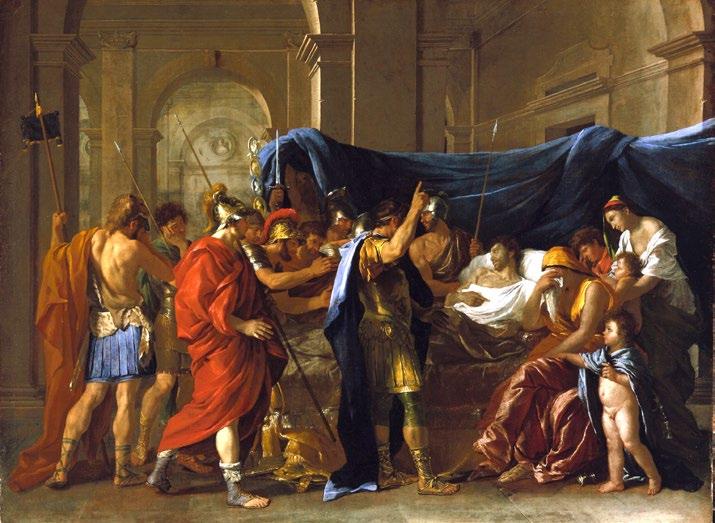
"Gold, like a shining fire in the night, makes even more excellent human wealth" (Pindar, First Olympic Ode).Nicolas Poussin, 1627: The Death of Germanicus (Minneapolis Institute of Art) Antonia the Younger, Ny Carlsberg Glyptothek, Copenhagen, Carole Raddato, Wikipedia Auction 383, Lot number 2060 Gaius Caligula, 37-41 and Germanicus. Aureus, 37/38, Rome. Very rare. Very fine. Estimate:
made of the death of Germanicus in Antioch. One of his friends is shown grasping the dying man’s right hand. With his own raised right hand the friend takes an oath to avenge the death of Germanicus. At the bedside sits the sobbing Agrippina; beside her is little Caligula, who is watching everything closely.
In the 1980s, bronze tablets were found in Spain upon which Senate resolutions ordering honours for the deceased Germanicus, and regarding the condemnation of Piso, are recorded. They indicate that the death of Germanicus was received with great shock everywhere in the Empire. The Spanish inscriptions also allow us to verify the reports in Tacitus about the death of Germanicus on the basis of original documents, and to better assess the work of this important historian.
One of the innovations of the Roman Empire was that women were quite often depicted on coins. With the establishment of the monarchy, women gained in importance because they played a major role in the continuation of the dynasty, and thus its retention of power. For this reason, the motherhood of these women is not infrequently thematised. However, some of these imperial women also understood how to gain considerable influence over current political developments. Behind the scenes, they often played the decisive role.
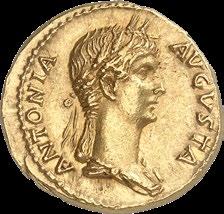

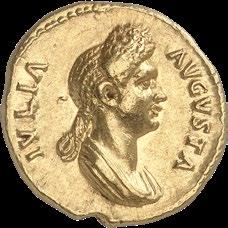 Antonia Minor
Antonia Minor
One of these important women of the Roman Imperial period was the aforementioned grandmother of the Emperor Caligula (37–41) and mother of the Emperor Claudius (41–54), Antonia Minor. Born around 36 BC, the daughter of Marc Antony and Augustus’ sister Octavia had married Livia’s son (and thus Augustus’ stepson), Drusus, in 16 BC. Drusus led quite successful campaigns in Germania from 12–9 BC. He and his descendants were therefore given the title ‘Germanicus’ as an honour. In Drusus’ time, Rome still had the idea that Germania could be conquered as far north as the Elbe River. During a campaign that took him that entire distance to the Elbe in 9 BC, he fell from his horse and was injured so severely that he died. His widow Antonia, after the death of her highly celebrated husband, did not marry again. She thereafter belonged to the inner circle of Livia, the wife of Augustus (31 BC – AD 14) and mother of the emperor who succeeded him, Tiberius (14–37 AD).
In the period that followed, Antonia suffered terrible blows of fate. In AD 19 her son Germanicus died in Antioch, where the governor of Syria was suspected of having poisoned him. In AD 29 Antonia’s patron Livia died, after which she focussed on her responsibilities in the upbringing of her grandsons Gaius (Caligula) and Drusilla. In AD 31, her daughter Livilla was convicted of spousal murder and involvement in a conspiracy against the Emperor Tiberius. Whether Livilla’s end came by suicide or execution remained a secret of the imperial house.
After Gaius/Caligula took power in AD 37, Antonia was soon driven to her own death by her former pupil. Possibly the mad emperor had bad memories of his grandmother’s educational methods. In this case, too, the exact circumstances can no longer be determined, as the palace was adept at hiding such nasty secrets from the public. Moreover, the historians of Rome were not as efficient as the paparazzi and the gossip press of our day. In an unpredictable development after Caligula’s death, his uncle Claudius, also a son of Antonia, became emperor. He honoured his mother, among other tributes, with a coinage of aurei following his assumption of power between 41–45 AD. The obverse of a beautiful aureus from the Wolf Collection shows the draped bust of Antonia. She wears a wreath of ears of corn, and is thus likened to the goddess of grain, Ceres (the Greek goddess Demeter). The legend of the coin reads ANTONIA AVGVSTA. Probably the learned Claudius wanted to emphasise Antonia’s role as a good mother by aligning her with the goddess Ceres. Myth tells of Ceres searching all the countries of the world after the underworld god Pluto (Hades) had abducted her daughter Proserpina (Persephone) into the underworld. This search for her daughter is also alluded to by the two torches in the image, which are connected by a ribbon; Ceres is often depicted searching the world for her daughter with one, but sometimes also with two torches in her hands. The legend of the coin notes that Antonia was a priestess of the divine Augustus: SACERDOS DIVI AVGVSTI.
Auction 383, Lot number 2061
Claudius, 41-54 for Antonia. Aureus, 41/45, Rome. Rare. Extremely rare.
Estimate: 15,000 euros
2:1
Auction 383, Lot number 2072
Domitianus, 81-96 for Julia Titi.
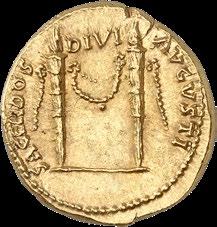
Aureus, 88/89, Rome.
The life of Julia (Flavia) is highly dramatic. She was the daughter of Emperor Titus (79–81 AD), who became most famous for conquering Jerusalem in AD 70 and completely destroying the Jewish Temple. The identity of Julia’s mother is disputed in view of uncertain historical accounts. She was born in Rome in early AD 61, i.e. during the reign of Emperor Nero. At that time, no one could have guessed that her grandfather Vespasian and later her father Titus would become emperors. After the death of Vespasian in AD 79, Julia’s father Titus became emperor and she was given the title of ‘Augusta’, which in this context can be translated as ‘Imperial Highness’. Probably in AD 81 she married a cousin of her father, T. Flavius Sabinus. When Julia’s father Titus died on 13 September AD 81, a family tragedy began to brew. Titus’ brother and successor in the imperial reign, Domitian, had his eye on his niece Julia, although he was married to a certain Domitia Longina. After Domitian had held the ordinary consulship – as had Julia’s husband Flavius Sabinus – from 1 to 31 January AD 82, he subsequently had his colleague Flavius Sabinus executed. The imperial biographer Suetonius, knowing of Domitian’s passion for Julia, tells us that Domitian seduced his niece Julia shortly after her marriage. Evidently, Julia was also attracted to her uncle, who was 10 years older than she: After the violent death of her husband, she became Domitian’s mistress. She is said to have had a not inconsiderable influence on his political orientation. Domitian’s wife Longina was banished from court because she, as well, had a history of many affairs and now represented a disturbance to the relationship of Domitian and Julia. However, when Domitian increasingly felt the need to produce an heir with his rightful wife, he recalled Domitia in AD 88, but even then would not abandon his beloved Julia.
This was evidenced by an issue of two aurei, one dedicated to Julia, the other to Domitia. The aureus dedicated to Julia is found in the Roger Wolf Collection (lot number 2072). On the aurei both women wear the same hairstyle with a high hair roll over the front of the head. A peacock is depicted on the reverse of both coins. In the case of Julia, the peacock spreads its magnificent tail, while Domitia’s peacock draws its glorious tail closed behind it. Julia is singled out in the legend of her coin as the daughter of the deified Titus; in Domitia’s case, the restored unity of the imperial couple is propagated. The coins reflect the fact that Domitian wanted to maintain his relationships with both women, and avoided any choice between them – which does not seem so atypical for men in such situations. At the end of AD 89, Julia died as a result of an abortion that Domitian is said to have urged her to undertake. She was consecrated, and henceforth venerated as Diva Julia. The peacock was the sacred animal of Juno/Hera, with whom empresses were often compared, for an “Augusta” was considered the earthly equivalent of the Queen of Heaven. A beautiful myth elaborates on the goddess Juno’s close relationship with the peacock: According to the story, Juno once surprised her unfaithful husband Jupiter with his lover Io. At the last minute, Jupiter turned the unfortunate Io into a cow. But this did not help him, for the suspicious Juno persuaded Jupiter to give her the Io-cow

2:1
Very rare. Very fine - extremely rare.
Estimate: 15,000 euros
as a gift. To make the cow thirsty, she tied her to a tree and sent the hundred-eyed giant Argos to guard her, so that she would get no water. When the Io-cow began to suffer from terrible thirst and roared in agony, Jupiter wanted to free her, and sent out his cunning son Hermes, who succeeded in putting the giant to sleep with his magic flute – such that all of the giant’s hundred eyes fell shut. Then Hermes cut off the giant’s head and untied Io. When Juno returned to the scene of the crime, she summoned her sacred bird, the peacock, which at that time still had inconspicuous plumage. She bored out all 100 of the giant’s eyes and pinned them to the peacock’s feathers, who has since been able to proudly display the iridescent eyes on its widespread tail, as illustrated by the artist Rubens in a beautiful painting. But Juno sent a gadfly after the Io cow, which made the poor cow-woman first jump into a sea subsequently named after her (the Ionian Sea) and then cross a strait twice (the Bosporus near İstanbul, and the Cimmerian Bosporus).

Elagabal
One of the most bizarre emperors of Rome was Elagabal. He was the son of a niece of Julia Domna, who had been empress from 193 to 217 – initially as the wife of Septimius Severus, then as the mother of Caracalla. Elagabal’s imperial name, which also encircles his portrait on the unusually well-preserved aureus in the Wolf Collection, was Marcus Aurelius Antoninus.
Born around AD 203 in the Syrian city of Emesa (today Homs), he was originally called Varius Avitus and was the scion of a priestly dynasty. At the centre of the cult they maintained was a black stone that had fallen from the sky, presumably a
meteorite, which was believed to be an image of the sun god. After the son of Septimius Severus and Julia Domna, Caracalla, had been murdered by a certain Macrinus on 8 April AD 217 -- and after Julia Domna had committed suicide in Antiocheia, Syria – Domna’s sister and her daughter attempted to regain for the Severan dynasty the imperial rule that Macrinus had usurped. By May AD 218, both women had rallied armies to their side, Elagabal was passed off as the son of Caracalla and proclaimed emperor at Emesa, and Macrinus was defeated in battle and killed shortly afterwards. As emperor, Varius Avitus took his father’s name, but was later called Heliogabalus/ Elagabal by historians because of his bizarre sun-stone worship: “Helios” is the Greek word for sun, “gabal” the Arabic word for rock or stone. In the East, these cultures had merged! Elagabal had the sacred stone of Emesa brought from Syria, across Asia Minor and the Balkans, to Rome by a team of horses. In August or September AD 219, emperor and stone arrived in Rome, and Elagabal declared his Syrian sun god to be the supreme god of Rome. He then proceeded to order that this god should be worshipped in the oriental manner. The Romans did not understand these rites, which were foreign to them, and considered some of them highly offensive. As a result, Elagabal’s reign ended in disaster – in March of AD 222, Elagabal was murdered and his body thrown into the Tiber. Moreover, the murdered man was scorned with the derisive names ‘Tiber Man’ and ‘Rubbish’. Iupiter Optimus Maximus, who adorned the Capitol, became once again the most important patron god of Rome and of the Imperium Romanum. Politically, the incident teaches what sensitive handling the introduction of new religious rites requires. The reverse of the associated aureus from the Wolf Collection (lot number 2096) shows a four-horse carriage in which the cloaked black stone is being transported, either on its way to Rome or during a procession in Rome.
From the 3rd century onwards, changes in climate triggered a massive migration of peoples. From the north in particular, peoples pushed into the Roman Empire and the Mediterranean region. In their ancestral settlement areas, they had no longer been able to produce profitable harvests due to a cooling of the climate. The Roman Empire, and at its head the emperors in Rome, came under great pressure because they could no longer guarantee the defence of the empire and its population. In the east, the Persians took advantage of this situation. When the Romans withdrew troops from the Euphrates border to deploy them on the Rhine and Danube borders against the invading Germanic tribes, the Persians broke into Syria and Asia Minor. In this terrible situation for the empire’s population – murder and death as well as massive looting were now part of everyday life in the once secure empire – the tormented population and discontented soldiers proclaimed their own emperors, especially in those areas where the enemy had invaded. These pseudo-emperors were regarded by the emperors in Rome as usurpers. However, the accused usurpers emphasised their newly-acquired positions by having gold coins minted with their images. They thus appropriated an exclusive imperial prerogative, thereby challenging the Roman emperors to an even greater extent. Such gold coins are a “claim coinage”.
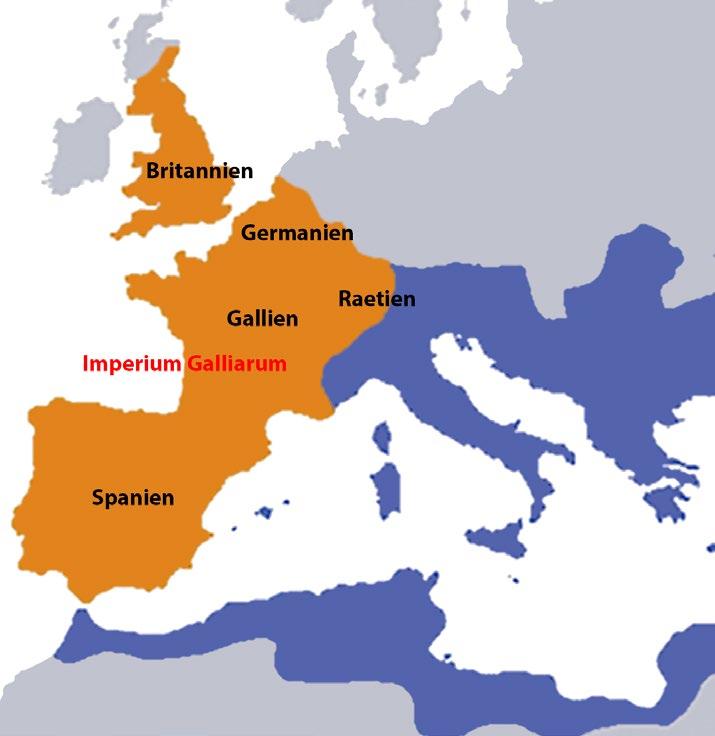
In the Wolf Collection there are two extremely rare and well-preserved specimens of these usurper coinages, one of Postumus (lot number 2111), and another of Uranius Antoninus (lot number 2110).
In July AD 253, a usurper named Uranius Antoninus had risen in Emesa, the city from which Elagabal had come. He was probably even related to Elagabal and, like him, was high priest of the sun cult of Emesa. His seizure of power was prompted by the threat to the city from the Persians. He was obviously able to successfully repel the Persian invasion; the goddess of victory Victoria on the reverse of his gold coin and the legend VICTORIA AVG(usta) indicate this. By minting a Roman aureus and the laurel wreath, he expressed a claim to imperial dignity.
taking their booty from them before they could retreat back across the Rhine. A dispute then arose with Saloninus, the son of the emperor Gallienus. Gallienus had sent Saloninus to Cologne to secure the Rhine border. When Saloninus claimed the Germanic booty for the state treasury and did not want to concede it to Postumus’ soldiers, an armed confrontation ensued. Postumus stormed Cologne, and Saloninus was slain. As a result, almost all Roman provinces in the west – in Britain, Germania, Gaul and Spain – and for a short time also Raetia, recognised Postumus as emperor. The Gallic Roman Empire was formed. Postumus, who henceforth resided in Cologne, was a capable military man who for a long time was able to keep the Alamanni and the Franks from plundering, by means of well-conducted campaigns. It is a peculiar irony of history that a usurper rose up against Postumus in Mainz in AD 269. Postumus was able to defeat him, but when he in turn forbade the soldiers to plunder Mainz, he was slain by them. The Gallic Roman Empire that Postumus had founded existed, albeit reduced in size, until AD 274, when Emperor Aurelian succeeded in reintegrating it into the Imperium Romanum.
2:1
Extremely
Estimate: 20,000 euros
2:1
Of the highest rarity. Extremely rare.
Estimate: 40,000 euros 2:1
However, he apparently gave this up immediately when Emperor Valerian came east from Rome in AD 254 and resided in Antiocheia, Syria. As quickly as he had entered, Uranius disappeared from the historical stage. As a result, however, aurei of Uranius Antoninus are extremely rare, especially in such good condition.
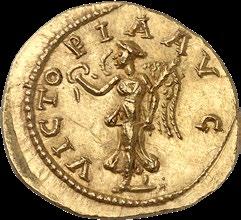




Postumus
Postumus seized power in the west in AD 260, when Franks and Alamanni had crossed the Rhine and plundered the open country in Germania and Gaul. Postumus, as military commander, had succeeded in confronting the looters and
Extremely rare. Small flan defect, extremely rare.
Estimate: 40,000 euros
The aureus of Postumus shows his own concept of his reign. On the obverse of the coins are the staggered portraits of Postumus and Hercules, whom Postumus saw as his patron god. He apparently considered his task of protecting and securing the western Roman Empire to be a Herculean one. The reverse again shows two staggered busts depicting two personifications, which can be recognised by their attributes. The winged being wearing a diadem in the foreground holds a wreath in her hand, and is therefore meant to be identified with Victoria, the goddess and personification of victory. Behind her another diadem-adorned woman holds an olive branch in her own hand. This is Pax, the divine peace. Their interaction creates that which the legend of the coin propagates, FELICITAS AVG(usta), or imperial bliss. With its pictorial programme, this coin illustrates a favourite maxim of the Romans, “Si pacem vis, para bellum”: “If you want peace, prepare for war!”


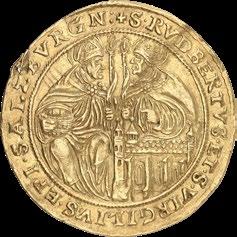


In our auction 384 we have the pleasure to offer a large collection of Salzburg coins. The most fascinating thing about this collection is that it reflects the entire history of Salzburg until its incorporation into the Austrian Empire in 1816. The Salzburg prince archbishops, most of whom came from noble houses, were among the more important ecclesiastical imperial princes from the early Middle Ages until the Congress of Vienna. They made religious, political and cultural history far beyond their dominions. Salzburg was also economically important as a lively trading city, which was very active in salt production and ore mining. In the battles between Protestants and Catholics, the archbishops of Salzburg tried to keep their domain free of Protestants in an emphatic but often very brutal way. Both Bavaria and Austria always tried to enforce their interests in the Archbishopric of Salzburg: When the ecclesiastical principality was dissolved, however, only the Berchtesgadener Land and the Rupertiwinkel fell to Bavaria; the greater part is now Austrian. The Archbishopric of Salzburg left behind particularly beautiful and aesthetic coins - made also to demonstrate its own wealth in precious metal deposits.
In 696, St. Rupert, a Frankish nobleman and bishop of Worms, came to Salzburg, the former Roman Municipium Iuvavum, in the course of the Christianization of the Alpine region. Here he encountered a strong Romanized remnant population and an early Christian monastic community that had settled there since late antiquity. Rupert built a large church in honor of St. Peter on the site of the present cathedral and founded a monastery according to the rules of St. Benedict. The religious community that developed there gave rise to the later cathedral chapter. With the building of the church and the establishment of the monastery, the history of the diocese of Salzburg begins. Donations by the Bavarian dukes, especially shares in the brine springs of Reichenhall, guaranteed the survival of the young diocese. Its ecclesiastical establishment took place only 20 years after the death of St. Rupert in 739 by Pope Gregory II and the 'Apostle of the Germans', St. Boniface.
Under the Irish-born Bishop Virgil (749-784), Salzburg’s second founding saint, Salzburg became a center of European art and culture. It was here that the precious Tassilo Chalice was made, and in the Monastery of St. Peter that the Anglo-Saxon Cutbercht created a precious gospel book, which today belongs to the treasures of the Vienna National Library. In 774, Virgil commissioned the construction of a three-nave cathedral, which is said to have eclipsed even the Frankish national shrine of St. Denis. The bones of St. Rupert, who became the patron saint and national saint of Salzburg, were transferred by Virgil from Worms and buried in the cathedral church. At the request of Charlemagne, Pope Leo III elevated Salzburg to an archbishopric on April 20, 798. It thus became the metropolitan see of the Bavarian Church with the suffragan bishoprics of Freising, Neuburg, Regensburg, Passau and Säben. This important ecclesiastical province encompassed not only at times the entire territory of the old Bavarian stem duchy, but also most of present-day Austria and South Tyrol, Trentino and large parts of Hungary, the Czech Republic, Slovenia and Slovakia.
The archbishops of Salzburg in the High Middle Ages proved to be energetic and faithful followers of the Roman popes. In return, these upright men of the church had to put up with personal danger and severe hardships for their diocese, especially during the time of the Investiture Controversy. In this struggle between secular and spiritual power over competences and priority, the main issue was the appointment of bishops. In the dispute between Pope Alexander III and Emperor Frederick I Barbarossa, who even imposed the imperial ban on Salzburg Archbishop Konrad II von Babenberg, the city suffered the worst catastrophe in its history: imperial troops burned down the city and the cathedral. His successor, Archbishop Konrad III of Wittelsbach, was able to begin rebuilding a three-nave basilica after peace was established in 1177. In later times, however, it was the Salzburg archbishops in particular who offered themselves as diplomatic mediators in conflicts between emperors and popes. As arch chaplains, they rendered valuable services to the Roman-German emperors and were rewarded with generous donations.
During his long reign from 1200 to 1246, Eberhard II succeeded in building up a closed archbishopric dominion. Gradually, the archbishopric of Salzburg began to break away from its motherland, Bavaria. The final phase of this development began around 1275 under Archbishop Frederick II. In 1328, the High Diocese of Salzburg received its own state constitution. In order to maintain its territorial independence, several military conflicts had to be fought with the powerful Bavarian dukes. But Austria, which was gaining in strength, also repeatedly tried to exert influence on Salzburg, which had important trade routes and rich mineral resources from the salt and ore mines in Tyrol and Styria. Under Konrad IV of Fohnsdorf-Paitenfurt (12911312), however, a clear turn towards Austria and the Habsburgs began. From now on, this attitude decisively determined the foreign policy of the archbishopric.

Lot number 2503 - Archbishopric of Salzburg. Eberhard II von Regensberg, 1200-1246. Penny, Salzburg.

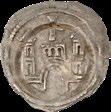

Very rare. Slight weak struck, very fine.
Estimate: 200 euros
Lot number 2522
Matthäus Lang von Wellenburg, 1519-1540.
4 Ducats 1522.
Very rare. NGC MS63. Extremely fine to FDC.
Estimate: 30.000 euros
Lot number 2590 - Archbishopric of Salzburg. Michael von Küenburg, 1554-1560.

Guldiner 1555. Fine patina, very fine-extremely fine.
Estimate: 400 euros
Lot number 2598 - Archbishopric of Salzburg. Johann Jakob Khuen von Belasi, 1560-1586.

4 ducats 1565. Extremely rare. Small test cut on the rim, incised value numeral III on the reverse, slightly wavy, otherwise very fine-precious.
Estimate: 15,000 euros
Cathedral of Salzburg
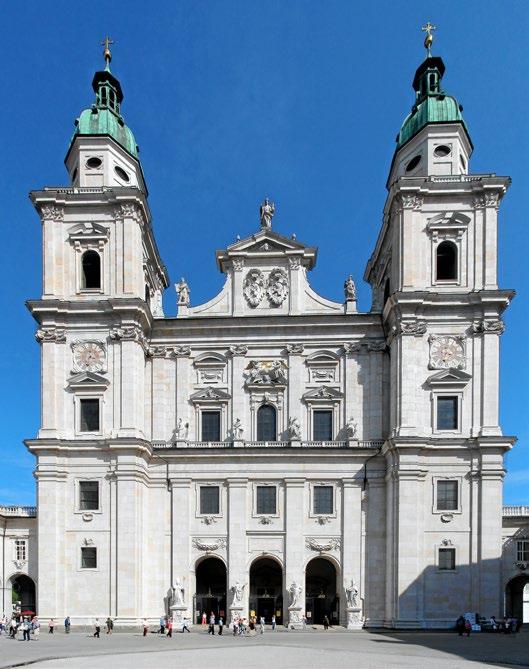
Archbishop Matthäus Lang von Wellenburg (1519-1540) had heard Luther speak at the Diet of Worms in 1521 and thereupon banned and criminalized Protestantism early on in the archdiocese. However, the archdiocese never joined the Catholic League and was thus able to cleverly stay out of the turmoil of the Thirty Years' War. From 1520, however, the Reformation spread heavily in Salzburg as well. Several Salzburg archbishops, including Michael von Küenburg, Johann Jakob Khuen von Belasi, Georg von Küenburg, Wolf Dietrich von Raitenau and Markus Sittikus, continued to take measures against the Protestants as part of the CounterReformation and Re-Catholicization, but without much success, because there continued to be numerous "secret Protestants" among the peasants in the Pongau and the miners in the country's mines. The story of the 'Salzburg Protestants' (German: Salzburger Exulanten) aroused great indignation throughout Europe: Prince-Archbishop Leopold Anton von Firmian decreed on October 31, 1731, that all Protestants (more than 20,000 people) were to leave the archdiocese within just three months, in violation of the provisions of the Peace of Westphalia. The Prussian King Frederick William I, wisely recognizing his opportunity, took in 17,000 Salzburg religious refugees ('Exulanten') and settled them in areas depopulated by a great wave of plague.
The archbishops of Salzburg had become princes within the Holy Roman Empire after about 1350 and from then on held the title of prince archbishop. Guidobald Count of Thun and Hohenstein (1654-1668) was the first 'Primas Germaniae' to sit on the spiritual bench of the Imperial Council of Princes in the Diet of the Holy Roman Empire. As imperial princes and sovereigns, they ruled entirely in the spirit of absolutism. The only counterweight to the overpowering spiritual and secular sovereign was the cathedral chapter, which before each election of a new archbishop made written demands, so-called 'electoral capitulations', in an attempt to limit the power of the future archbishop. This led to numerous, serious disputes between the cathedral chapter and prince-bishops, which in some cases could only be settled by the pope. Pope Innocent XII finally issued a general ban on electoral capitulations in 1695.
Clever politics and economical administration enabled the archiepiscopal sovereigns to make Salzburg a center of culture, education (founding of the Benedictine University in 1628) and art in the early modern period. Thus, in the 17th and 18th centuries, the prince-archbishops did their utmost to create lasting monuments for themselves by building the enormous cathedral, baroque palaces, churches, house facades, gardens and fountains. In the process, Wolf- Dietrich von Raitenau, Markus Sittikus, Paris Lodron, Guidobald von Thun und Hohenstein, Franz Anton von Harrach and Leopold Anton von Firmian changed the appearance of the medieval old town from the ground up and made it what it is today: a unique baroque jewel and 'the Rome of the North', which has been protected as a World Heritage Site since 1995. Renowned Italian architects such as Vicenzo Scamozzi, Giovanni Zuccalli and Santino Solari were commissioned to design the Mirabell and
Lot number 2671
Wolf Dietrich von Raitenau, 1587-1612.
10 Ducats 1587.
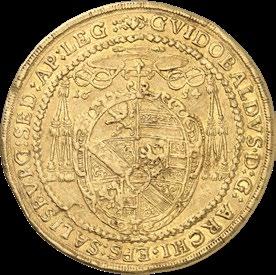
Extremely rare. NGC AU58. Extremely fine.
Estimate: 40.000 euros
Hellbrunn palaces and to develop Hohensalzburg into a strong fortress, too. Prince-Archbishop Johann Ernst von Thun und Hohenstein became an important patron of German Baroque art. Johann Bernhard Fischer von Erlach built Klessheim Palace at the gates of Salzburg, and the Bavarian painter Michael Rottmayr created the ceiling paintings in the Residenz and Mirabell Palace. Hieronymus von Colloredo, the last reigning prince-archbishop of the archdiocese of Salzburg and a progressive mind in the spirit of the Enlightenment, attracted leading scientists, writers and, above all, musicians such as Joseph Haydn and Wolfgang Amadeus Mozart to his court. After the secularization in 1803, the archbishops no longer ruled Salzburg as sovereigns. As the Electorate of Salzburg, it fell to the Grand Duke Ferdinand III of Tuscany together with the former prince-bishoprics of Berchtesgaden, Passau and Eichstätt. After the Congress of Vienna in 1816, most of Salzburg was finally annexed to Austria as the Salzburg County.
Lot number 2737 - Archbishopric of Salzburg. Markus Sittikus von Hohenems, 1612-1619. Double ducat 1615. Extremely rare.


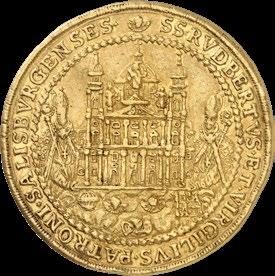

Very attractive example with fine gold toning, excellent +.
Estimate: 7,500 euros
Lot number 2950
Johann Ernst von Thun und Hohenstein, 1687-1709.
25 Ducats 1687.
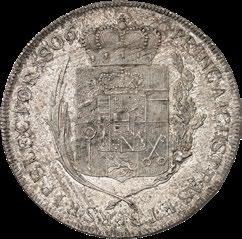
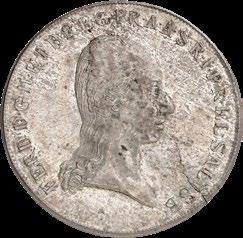

Extremely rare. Extremely fine +.
Estimate: 75.000 euros
Lot number 2590 - Archbishopric of Salzburg. Michael von Küenburg, 1554-1560. Guldiner 1555.
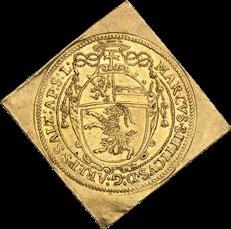
Fine patina, very fine-extremely fine.
Estimate: 400 euros
Lot number 2774 - Archbishopric of Salzburg. Paris of Lodron, 1619-1653. 4 ducats 1629. Very rare.



Fine gold patina, with incised value numeral IIII on the reverse, almost extremely fine.
Estimate: 10,000 euros
Lot number 2855 - Archbishopric of Salzburg. Guidobald of Thun and Hohenstein, 1654-1668. 10 ducats 1654. Of the highest rarity.
Slightly bent, small edge fault, very fine.
Estimate: 15,000 euros
Lot number 3025 - Archbishopric of Salzburg. Franz Anton von Harrach, 1709-1727. ½ ducat 1715. Rare. Attractive piece. Extremely fine-uncirculated.


Estimate: 750 euros
Lot number 3081 - Archbishopric of Salzburg. Leopold Anton Eleutherius von Firmian, 1727-1744. Reichstaler 1739. Rare. Attractive piece.
Magnificent patina, extremely fine-uncirculated.
Estimate: 1,000 euros
Lot number 3182 - Archbishopric of Salzburg. Hieronymus von Colloredo, 1772-1803.
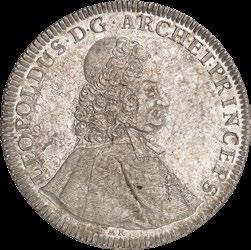



Ducat 1782. Rare. Extremely fine.

Estimate: 1,250 euros
Lot number 3251 - Electorate of Salzburg. Ferdinand, 1803-1806.
Convention thaler 1806.
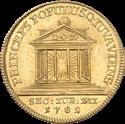
Fine toning, fland defect, about extremely fine.
Estimate: 200 euros
For many years now, our first auction of the year has been held in conjunction with the Berlin World Money Fair. There is a good reason for this. This coin fair, with the highest attendance of any in Europe, is wonderful terrain for meeting our customers in person.





Lot number 2 - Anhalt
Johann Georg I, Christian I, August, Rudolf and Ludwig, 1603-1618. Thick double Reichstaler 1615.
Estimate: 7,500 euros, hammer price: 15,000 euros
After the great success of the last World Money Fair, which was held last summer instead of in January as usual, we were very much looking forward to the current 50th edition of this coin fair. Nowhere do we get to talk more closely with our customers. Here we learn from you what moves you as buyers. That’s why you will find a Künker team and a Künker booth at this and so many other coin fairs. For us, this is an important part of customer care.
The day before the fair opened, our Berlin auctions 379 and 380 took place, and we were overwhelmed by how full our auction room was. It was so good to see so many faces again, and to feel that everyone was taking great pleasure in the bidding wars. The auction lasted until after 8 pm and set several records.
The next day, the World Money Fair opened its doors. Long queues formed at the entrance, and it was like going back in time. We had not seen so many people at once at a numismatic event since before the long pandemic period.

There are no reliable figures yet, but it felt as if we were witnessing a record number of visitors. Thousands of collectors filled the halls to buy coins and medals for their own collections. Older colleagues spoke of how this buying frenzy reminded them of the 1970s!
Lot number 56 - Wallenstein.
Albrecht, 1623-1634, Duke of Friedland. Double reichstaler 1627, Jitschin. From the Salton Collection. Extremely rare. Very fine +.
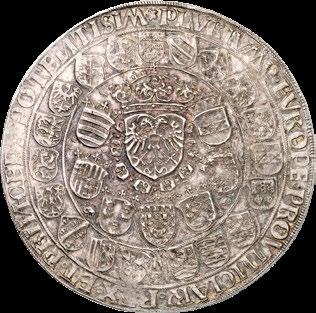
Estimate: 30,000 euros. Hammer price: 95,000 euros
Lot number 61 - Anhalt
Johann Georg I, Christian I, August, Rudolf and Ludwig, 1603-1618. Thick double Reichstaler 1615.


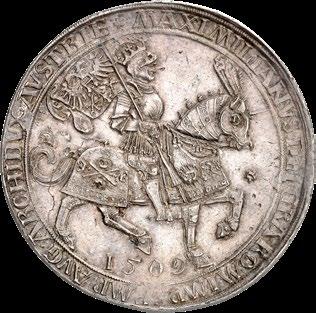
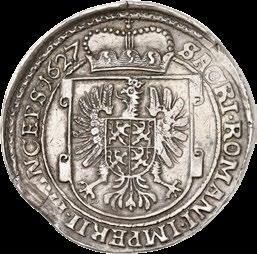
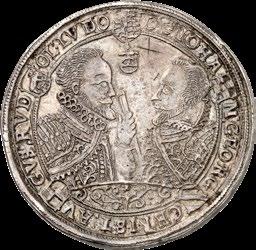

Estimate: 7,500 euros, hammer price: 15,000 euros
Lot number 288 - Great Britain. Victoria, 1837-1901. 5 pounds 1839, London. “Una and the Lion”. NGC PF63 CAMEO (Top Pop). Very rare. Proof.
Estimate: 100,000 euros. Hammer price: 420,000 euros
Gold coins in particular were in huge demand. It was good that our team from the Gold Trading division had prepared for this. We were able to satisfy the buying wishes of collectors interested in historical gold coins to a great extent. But our colleagues at the other tables also enjoyed excellent sales. And what was happening at the booths of the mints surprised even us. The Japan Mint, to name just one example, offered a special annual coin set from 2023 with a medal in World Money Fair packaging, for 20 euros. Their 500 sets were sold out after less than two hours. The Croatian mint, which minted Croatian euros for the first time for 2023, exchanged Croatian one-euro pieces from a huge sack for other European one-euro coins. The sack was already empty by Saturday morning. And the supply of our special WMF panda was also sold out after only half a day.
So one may conclude: All coin sales are booming – from the low-price sector of two-euro commemorative coins to the expensive individual pieces with five- and six-figure estimates. But what pleased us most was something completely different, namely the incredibly positive atmosphere that prevailed at the World Money Fair. Everyone was happy to be back.
Lot number 341 - Kingdom of Sweden
Johann III, 1568-1592. 2 rosenobler (1/2 Portugalöser) o. J. (1585/1586), Stockholm. Variant with leaves in the inner reverse inscription.

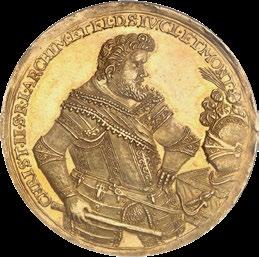

Estimate: 25,000 euros, hammer price: 65,000 euros
Lot number 542 - United States of America / USA
50 Dollars 1915, San Francisco.
Estimate: 60,000 euros, hammer price: 75,000 euros
Lot number 835 - Saxony.
Christian II, Johan Georg I and Augustus, 1591-1611. 10 ducats 1611, Dresden. Commemorating the death of Christian II. From MMAG auction 7 (1948), No. 130. Extremely rare. NGC MS65. About FDC.
Estimate: 250,000 euros. Hammer price: 340,000 euros